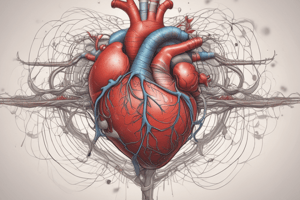Podcast
Questions and Answers
Which of the following is NOT a part of the heart's internal structure?
Which of the following is NOT a part of the heart's internal structure?
- Right atrium
- Left pulmonary artery
- Superior vena cava
- Aorta (correct)
What is the primary function of the right ventricle?
What is the primary function of the right ventricle?
- Receiving oxygenated blood from the lungs
- Pumping deoxygenated blood to the lungs (correct)
- Pumping oxygenated blood to the body
- Receiving deoxygenated blood from the body
Which blood vessel carries deoxygenated blood from the body to the heart's right atrium?
Which blood vessel carries deoxygenated blood from the body to the heart's right atrium?
- Left pulmonary artery
- Left pulmonary vein
- Inferior vena cava
- Superior vena cava (correct)
Which part of the heart receives blood from the veins?
Which part of the heart receives blood from the veins?
What is the correct order of blood flow through the heart and lungs?
What is the correct order of blood flow through the heart and lungs?
Which statement BEST describes the function of the heart's valves?
Which statement BEST describes the function of the heart's valves?
What is the primary function of heart valves?
What is the primary function of heart valves?
During the activity, what is the primary variable being measured to assess the effect of exercise on the heart?
During the activity, what is the primary variable being measured to assess the effect of exercise on the heart?
Which of the following is the most likely outcome of the activity regarding the effect of exercise on heart rate?
Which of the following is the most likely outcome of the activity regarding the effect of exercise on heart rate?
Based on the information provided about the heart's function, which of the following is NOT a direct consequence of the heart's contraction?
Based on the information provided about the heart's function, which of the following is NOT a direct consequence of the heart's contraction?
Flashcards
Location of the heart
Location of the heart
The heart is located between the lungs, behind the sternum, slightly to the left.
Heart muscle
Heart muscle
The muscular tissue of the heart is called myocardium, responsible for its contractions.
Four chambers of the heart
Four chambers of the heart
The heart has two atria (upper) and two ventricles (lower) for pumping blood.
Blood flow process
Blood flow process
Signup and view all the flashcards
Oxygenated blood return
Oxygenated blood return
Signup and view all the flashcards
Heart Function
Heart Function
Signup and view all the flashcards
Heartbeat Sequence
Heartbeat Sequence
Signup and view all the flashcards
Heart Valves
Heart Valves
Signup and view all the flashcards
Measuring Heart Rate
Measuring Heart Rate
Signup and view all the flashcards
Effect of Exercise
Effect of Exercise
Signup and view all the flashcards
Study Notes
The Heart
- The heart is a vital organ in the circulatory system
- It's located in the chest, slightly to the left of center
- It's roughly the size of a fist
- The heart is responsible for pumping blood throughout the body
- It has four chambers: two atria and two ventricles
- The right side receives deoxygenated blood and pumps it to the lungs
- The left side receives oxygen-rich blood from the lungs and pumps it to the body
- Valves in the heart prevent the backflow of blood
Heart Function
- The heart's primary roles involve receiving and pumping blood
- It carries oxygen and other nutrients throughout the body.
- Heartbeat is the rhythmic contraction and relaxation of heart muscle
- Blood flow is driven by the heart's contractions.
- The flow of blood is regulated by heart valves.
Circulation
- Blood travels in a continuous loop throughout the body;
- Blood is circulated through arteries and veins, carrying oxygen to body tissues and returning carbon dioxide to the lungs.
- Deoxygenated blood travels from body to the heart then to the lungs
- Oxygenated blood travels from the lungs to the heart then to the body.
Heart Structure
- The heart comprises four chambers: two atria and two ventricles
- These chambers are separated by valves which prevent backflow.
- Atria receive blood, ventricles pump it out
Studying That Suits You
Use AI to generate personalized quizzes and flashcards to suit your learning preferences.




